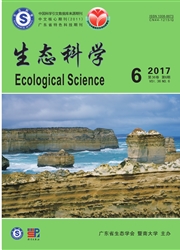

 中文摘要:
中文摘要:
于2010年9月采集南澳海域鱼类养殖区、贝类养殖区、大型藻类栽培区和对照区4个功能区表层沉积物样品,分析沉积物中生物硅(BSi)、总有机碳(TOC)、总氮(TN)和总磷(TP)4种生源要素的含量。结果表明,南澳海域生源要素含量与国内外养殖区相比属于中等水平。鱼类养殖区TOC、TN、TP的含量最高,而BSi的最高含量出现在藻类栽培区(平均含量为0.30%)。鱼类养殖区BSi、TOC、TN和TP的平均含量分别为0.24%、0.89%、0.13%和0.097%。根据沉积物中TOC/TN比值分析,发现鱼类养殖区的TOC主要来源于水生,贝类、藻类和对照区TOC则主要来源于陆源。生源要素污染评价表明,4个功能区的TN均属于Ⅱ类污染,鱼类和贝类养殖区的TP属于Ⅱ类轻度污染。
 英文摘要:
英文摘要:
The concentrations of biogenic elements including biogenic silica(BSi), total organic carbon(TOC), total nitrogen(TN) and total phosphorus(TP) were determined in surface sediments collected from marine fish cage culture zones, shellfish culture zones, Gracilaria cultivation zones and nature zones of Nan'ao, Shantou in September, 2010. Results showed that concentrations of biogenic elements were within moderate levels compared with those from other mariculture areas in the world. Contents of TOC, TN, TP in the fish culture zones were the highest; while the highest contents of BSi in Gracilaria culture zones (the average contents of BSi was 0.30%) in the all survey zones. The average contents of BSi, TOC, TN, and TP were 0.24%, 0.89%, 0.13% and 0.097% in marine fish cage culture zone, respectively. According the results of TOC/TN ratios, resources of TOC in the fish culture zones were from water bodies, from land in the other zones. Contamination assessment of biogenic elements indicated that TN in the four zones were in the Class II pollution, TP in the Class II pollution in the fish culture zone and shellfish culture zone.
 同期刊论文项目
同期刊论文项目
 同项目期刊论文
同项目期刊论文
 Community level phisiological study of algicidal bacteria in the phycosphere of Skeletonema costatum
Community level phisiological study of algicidal bacteria in the phycosphere of Skeletonema costatum Selenium accumulation in unicellular green alga Chlorella vulgaris and its effects on antioxidant en
Selenium accumulation in unicellular green alga Chlorella vulgaris and its effects on antioxidant en Seasonal Changes in the Invertebrate Community of Granular Activated Carbon Filters and Control Tech
Seasonal Changes in the Invertebrate Community of Granular Activated Carbon Filters and Control Tech Inhibition of marine coastal bloom-forming phytoplankton by commercially cultivated Gracilaria leman
Inhibition of marine coastal bloom-forming phytoplankton by commercially cultivated Gracilaria leman 期刊信息
期刊信息
